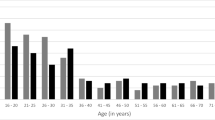Abstract
To validate a new modified method for measuring the anthropometric Haller index (HI), obtained without radiological exposure. This new method was based on the use of a rigid ruler and of a 2.5 MHz ultrasound transducer for the assessment of latero-lateral and antero-posterior chest diameters, respectively. We enrolled 100 consecutive patients (mean age 67.9 ± 14.5 years, 55% males), who underwent a two-plane CXR, for any clinical indication, over a four-month period. In all patients, the same radiologist calculated the conventional radiological HI (mean value 1.93 ± 0.35) and the same cardiologist used the above described new technique to measure the modified HI (mean value 1.99 ± 0.26). The Bland–Altman analysis showed tight limits of agreement (+ 0.37; − 0.51) between the two measurement methods, with a mild systematic overestimation of the new method as compared to the standard radiological HI. The Pearson’s correlation analysis highlighted a strong correlation between the two methods (r = 0.81, p < 0.0001), while the Student’s t test demonstrated a not statistically difference between the means (p = 0.12). The modified HI might allow a quick description of the chest conformation without radiological exposure and a more immediate comprehension of its possible influence on the cardiac kinetics and function, as assessed by echocardiography or other imaging modalities.





Similar content being viewed by others
References
Haller JA, Kramer SS, Lietman A (1987) Use of CT scans in selection of patients for pectus excavatum surgery: a preliminary report. J Pediatr Surg 22:904–906
Rebeis EB, Campos JRM, Fernandez A, Moreira LFP, Jatene FB (2007) Anthropometric index for pectus excavatum. Clinics 62(5):599–606
Archer JE, Gardner A, Berryman F, Pynsent P (2016) The measurement of the normal thorax using the Haller index methodology at multiple vertebral levels. J Anat 229(4):577–581
Kuru P, Cakiroglu A, Er A, Ozbakir H, Cinel AE, Cangut B, Iris M, Canbaz B, Pıçak E, Yuksel M (2016) Pectus excavatum and pectus carinatum: associated conditions, family history, and postoperative patient satisfaction. Korean J Thorac Cardiovasc Surg 49(1):29–34
Rattan AS, Laor T, Ryckman FC, Brody AS (2010) Pectus excavatum imaging: enough but not too much. Pediatr Radiol 40(2):168–172
Khanna G, Jaju A, Don S, Keys T, Hildebolt CF (2010) Comparison of Haller index values calculated with chest radiographs versus CT for pectus excavatum evaluation. Pediatr Radiol 40(11):1763–1767
Poston PM, McHugh MA, Rossi NO, Patel SS, Rajput M, Turek JW (2015) The case for using the correction index obtained from chest radiograpghy for evaluation of pectus excavatum. J Pediatr Surg 50(11):1940–1944
Mueller C, Saint-Vil D, Bouchard S (2008) Chest X-ray as a primary modality for preoperative imaging of pectus excavatum. J Pediatr Surg 43(1):71–73
Marcovici PA, LoSasso BE, Kruk P, Dwek JR (2011) MRI for the evaluation of pectus excavatum. Pediatr Radiol 41(6):757–758
Raichura N, Entwisle J, Leverment J, Beardsmore CS (2001) Breath-hold MRI in evaluating patients with pectus excavatum. Br J Radiol 74(884):701–708
Herrmann KA, Zech C, Strauss T, Hatz R, Schoenberg S, Reiser M (2006) Cine MRI of the thorax in patients with pectus excavatum. Radiologe 46(4):309–316
Rebeis EB, Campos JR, Moreira LF, Pastorino AC, Pêgo-Fernandes PM, Jatene FB (2013) Variation of the Anthropometric Index for pectus excavatum relative to age, race, and sex. Clinics 68(9):1215–1219
Author information
Authors and Affiliations
Corresponding author
Ethics declarations
Conflict of interest
We wish to confirm that there are no conflicts of interest associated with this publication. Andrea Sonaglioni declares that he has no conflict of interest. Massimo Baravelli declares that he has no conflict of interest. Antonio Vincenti declares that he has no conflict of interest. Roberta Trevisan declares that she has no conflict of interest. Maurizio Zompatori declares that he has no conflict of interest. Gian Luigi Nicolosi declares that he has no conflict of interest. Michele Lombardo declares that he has no conflict of interest. Claudio Anzà declares that he has no conflict of interest.
Ethical standard
All procedures performed in the present study were in accordance with the ethical standards of the institutional research committee and with the 1964 Helsinki declaration and its later amendments or comparable ethical standards.
Informed consent
Informed consent was obtained from all individual participants included in the study.
Rights and permissions
About this article
Cite this article
Sonaglioni, A., Baravelli, M., Vincenti, A. et al. A New modified anthropometric haller index obtained without radiological exposure. Int J Cardiovasc Imaging 34, 1505–1509 (2018). https://doi.org/10.1007/s10554-018-1366-5
Received:
Accepted:
Published:
Issue Date:
DOI: https://doi.org/10.1007/s10554-018-1366-5




